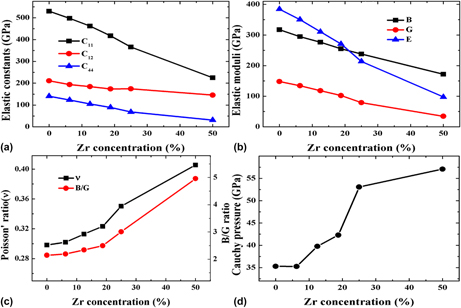Crossref Citations
This article has been cited by the following publications. This list is generated based on data provided by
Crossref.
Pan, Yong
and
Jia, Yanlin
2019.
First-principles study of structure and mechanical properties of TMB12(TM = W and Ti) superhard material under pressure.
Journal of Materials Research,
Vol. 34,
Issue. 20,
p.
3554.
Jiang, Diyou
Wu, Musheng
Liu, Desheng
Li, Fangfang
Chai, Minggang
and
Liu, Sanqiu
2019.
Structural Stability, Electronic Structures, Mechanical Properties and Debye Temperature of Transition Metal Impurities in Tungsten: A First-Principles Study.
Metals,
Vol. 9,
Issue. 9,
p.
967.
Sal, Elisa
García-Rosales, Carmen
Schlueter, Karsten
Hunger, Katja
Gago, Mauricio
Wirtz, Marius
Calvo, Aida
Andueza, Iñigo
Neu, Rudolf
and
Pintsuk, Gerald
2020.
Microstructure, oxidation behaviour and thermal shock resistance of self-passivating W-Cr-Y-Zr alloys.
Nuclear Materials and Energy,
Vol. 24,
Issue. ,
p.
100770.
Jiang, Diyou
Zhong, Shuying
Xiao, Wenbo
Liu, Desheng
Wu, Musheng
and
Liu, Sanqiu
2020.
Structural, mechanical, electronic, and thermodynamic properties of pure tungsten metal under different pressures: A first‐principles study.
International Journal of Quantum Chemistry,
Vol. 120,
Issue. 13,
Roldán, A Marín
Dwivedi, V
Veis, M
Atikukke, S
van der Meiden, H
Držík, M
and
Veis, P
2021.
Quantification of hydrogen isotopes by CF-LIBS in a W-based material (WZr) at atmospheric pressure: from ns towards ps.
Physica Scripta,
Vol. 96,
Issue. 12,
p.
124061.
Pan, Yong
2021.
Influence of transition metal on the mechanical and electronic properties of RuB2 from first-principles calculations.
Chemical Physics Letters,
Vol. 783,
Issue. ,
p.
139043.
Zhou, Xilin
Li, Guijin
Guo, Fangfang
Xue, Li
Huang, Xiaohua
and
Jiang, Diyou
2021.
First principles investigation of the Structural, Mechanical, Electronic Properties and Debye temperature of W-Co alloys.
Fusion Engineering and Design,
Vol. 170,
Issue. ,
p.
112715.
Xue, Li
Wang, Xunjie
Xue, Fei
Zhou, Xilin
Guo, Fangfang
and
Jiang, Diyou
2021.
Structural, mechanical, electronic properties and Debye temperature of tungsten-technetium alloy: A first-principles study.
Fusion Engineering and Design,
Vol. 168,
Issue. ,
p.
112433.
Jiang, Diyou
Xiao, Wenbo
Liu, Desheng
and
Liu, Sanqiu
2021.
Structural stability, electronic structures, mechanical properties and debye temperature of W-Re alloys: A first-principles study.
Fusion Engineering and Design,
Vol. 162,
Issue. ,
p.
112081.
Jiang, Diyou
Xiao, Wenbo
and
Liu, Sanqiu
2021.
Structural, mechanical, electronic properties, and Debye temperature of quaternary carbide Ti3NiAl2C ceramics under high pressure: A first-principles study*
.
Chinese Physics B,
Vol. 30,
Issue. 3,
p.
036202.
Wei, Lei
Yu, Jing
Yao, Lihua
and
Zhang, Lei
2022.
Effect of hydrostatic pressure on the mechanical, thermodynamic, and optical properties of orthorhombic WAlB.
Journal of Materials Research,
Vol. 37,
Issue. 23,
p.
4232.
Xing, Lina
Liu, Xingwei
Cao, Zhanmin
He, Chuan
and
Liu, Jinxu
2022.
Effect of increasing Ti content on the phase, interface, dynamic mechanical properties and ballistic performance of W–Ti–Zr alloys.
Materials Science and Engineering: A,
Vol. 831,
Issue. ,
p.
142196.
Smirnova, E. A.
Ponomareva, A. V.
Konov, D. A.
and
Belov, M. P.
2023.
A systematic description of the thermodynamic, elastic and mechanical properties of binary Zr-based bcc alloys from first principles.
Физика металлов и металловедение,
Vol. 124,
Issue. 6,
p.
500.
Chen, Yun
Tang, Lu
Cai, Houdao
Zhang, Meiyun
Wang, Xunjie
and
Jiang, Diyou
2023.
Effect of osmium substitution on structural, electronic, mechanical, and thermodynamic properties of W–Os alloys: A first-principles study.
Journal of Materials Research,
Vol. 38,
Issue. 3,
p.
883.
Smirnova, E. A.
Ponomareva, A. V.
Konov, D. A.
and
Belov, M. P.
2023.
A Systematic First-Principles Description of the Thermodynamic, Elastic, and Mechanical Properties of Zr-Based Binary BCC Alloys.
Physics of Metals and Metallography,
Vol. 124,
Issue. 6,
p.
583.
Jiang, Diyou
Li, Songsong
He, Kerong
Hu, Wei
Wan, Haiqing
and
Liu, Sanqiu
2023.
Excellent high temperature elasticity and thermodynamic properties of W-Cr alloys: A first-principles study.
Nuclear Materials and Energy,
Vol. 34,
Issue. ,
p.
101367.
Zhao, Xiaojian
Liang, Yan
Tian, Ruizhen
Li, Guijin
Zhou, Xilin
Wan, Haiqing
and
Jiang, Diyou
2024.
Theoretical investigation of structural, electronic, mechanical and thermodynamic properties of W-Ru alloys: Promising high temperature alloy materials.
Fusion Engineering and Design,
Vol. 204,
Issue. ,
p.
114521.
Das, Bappa
Khan, Atiqur Rahman
and
Patra, Anshuman
2024.
Effect of Nano-Cr2O3 Dispersed W-Zr Alloys by Mechanical Alloying and Pressureless Conventional Sintering.
Journal of Materials Engineering and Performance,
Vol. 33,
Issue. 11,
p.
5236.
Taluts, N.I.
and
Dobromyslov, A.V.
2024.
Structure of quenched Zr-W alloys.
International Journal of Refractory Metals and Hard Materials,
Vol. 121,
Issue. ,
p.
106658.
Wu, Runsheng
Liu, Dongyang
Lai, Junjie
and
Jiang, Diyou
2024.
Prediction of high temperature mechanical and thermodynamic properties of W-Mn alloys based on first principles method.
Fusion Engineering and Design,
Vol. 200,
Issue. ,
p.
114218.



